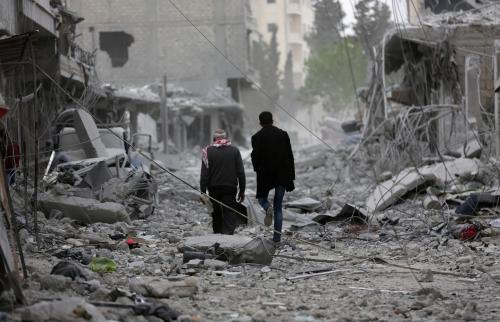If the United States does strike Syria, as the president is clearly signaling, it should be part of a broader strategy rather than just a pinprick that will make us feel good about standing up to a murderous dictator but do nothing to change the situation on the ground. But “part of a broader strategy” is one of those things analysts like me love to say but, even as they do so, ignore the hard choices involved. Here are a few to consider as we move forward:
1Do we accept an Assad victory? President Obama declared Assad must step aside after the conflict broke out in 2011, and in rhetoric the United States still seeks his removal. Yet, with Iranian and Russian help, Assad has secured his control over much of the country. Like it or not, he will probably be in power for years to come. Accepting this reality, however, does not mean completely giving up on various opposition factions, but it does limit the scope of any political settlement.
2Syrian Kurds or Turkey? The United States has worked closely with a faction among Syria’s Kurds to defeat the Islamic State, the primary U.S. policy objective in Syria. Yet Turkey, which is bitterly opposed to any power for Syria’s Kurds, is a NATO ally and regional power. Making this choice harder, Ankara is also steadily moving from democracy to dictatorship and starting to cozy up to Moscow. History suggests the United States will again sell out the Kurds, but trying to work with both will be difficult and perhaps impossible.
3Do we continue to deploy large numbers of troops, and if so how many? This issue was hotly debated before the latest chemical attack, with Trump disagreeing with his senior advisers. To shape events on the ground, limit Iranian influence, and otherwise have a seat at the table, the United States needs more skin in the game. But without a long-term plan, it is unclear what a seat at the table really brings. And even a few thousand troops may not be enough to truly shape things.
4How much do we confront Russia? Moscow has played a mediocre hand well in Syria, using its air force and limited ground assets to help the regime win and to demonstrate that it—unlike the United States—will deliver for its allies. Now it claims to act as a shield for Syria against a U.S. response. Trump has avoided confronting Russia even as he has alienated almost every U.S. ally, but it is hard to act against Assad without friction with Moscow.
5Will we manage the spillover? The Syrian civil war, and the worsening Iran-Saudi rivalry, shows up in the Saudi and Iranian interventions in Yemen, Israeli bombing raids, and the always-fractious Lebanese politics, among other regional problems. Historically, the United States has tried to work with its allies to reduce disagreements among them and use their joint influence to calm tensions. Trump has abandoned this role, but being serious about Syria requires a regional policy as well as one focused on Syria itself.
The Brookings Institution is committed to quality, independence, and impact.
We are supported by a diverse array of funders. In line with our values and policies, each Brookings publication represents the sole views of its author(s).








Commentary
5 hard choices in Syria
April 11, 2018